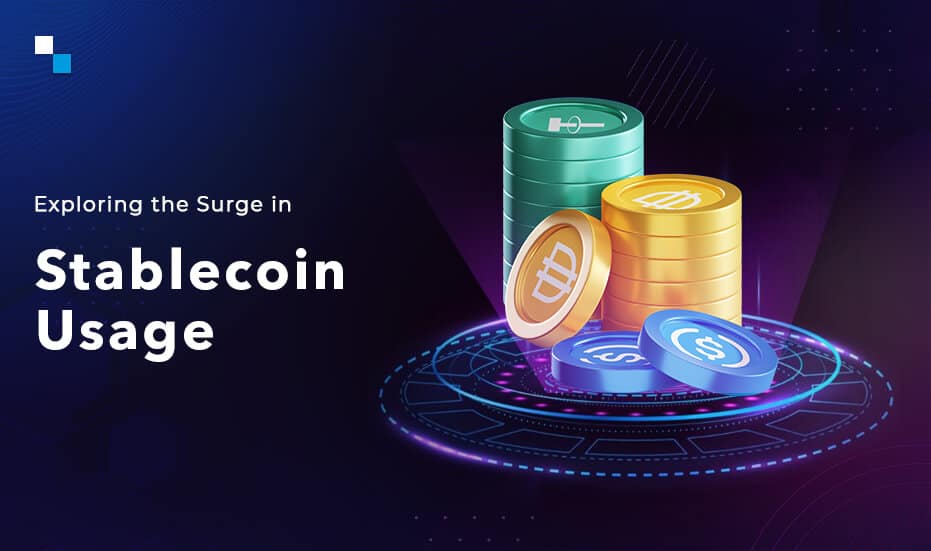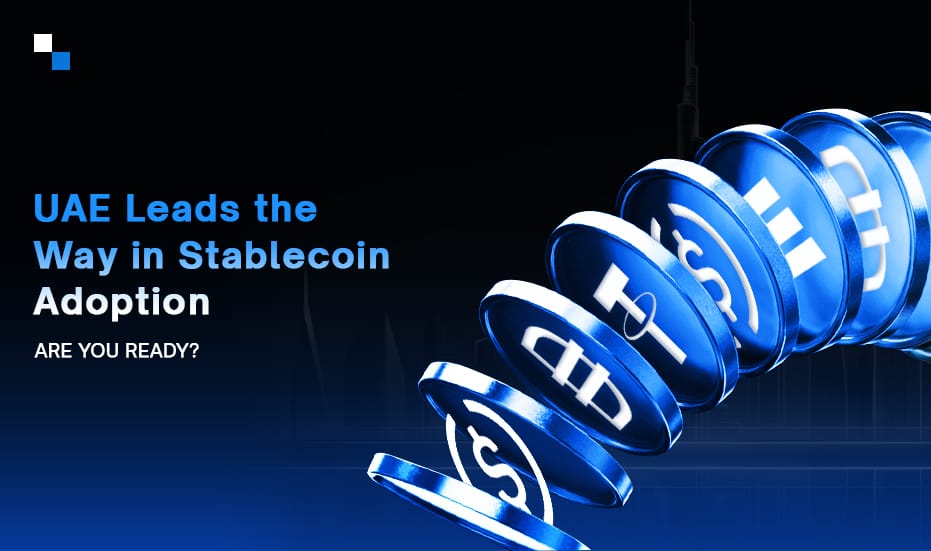
How Blockchain Streamlines the Carbon Offsetting Process in the Automotive Industry?
August 3, 2023
Why is Runtime Module Library (RML) A Game-Changer for Substrate Development?
August 4, 2023In recent years, stablecoins have emerged as a vital component of the cryptocurrency ecosystem, gaining significant traction among investors, businesses, and the general public. Unlike traditional cryptocurrencies like Bitcoin or Ethereum, stablecoins are designed to maintain a stable value by pegging them to a stable asset, such as a fiat currency, gold, or commodity. This stability offers users a reliable medium of exchange, a store of value, and a unit of account, reducing the price volatility commonly associated with other cryptocurrencies.
“As of the end of January 2023, Ethereum had a 59.9% market share across all stablecoins. Tron was second with a 26.5% market share.”
Factors Behind The Growing Demand for StableCoin Development
Stablecoins enable businesses to reach unbanked or underbanked populations, promoting financial inclusion and expanding market reach. These digital assets offer a means for individuals without access to traditional banking services to participate in the global economy.
William Quigley, the co-founder of the WAX blockchain and one of the inventors of USDT issuer Tether, says, “You’d need to have a Chinese bank account, a Japanese bank account and a European bank account”
There are numerous reasons behind the increasing use of stablecoins and their impact on the financial landscape. Let’s explore:
1. Price Stability and Risk Mitigation
One of the primary reasons for the growing popularity of stablecoins is their ability to mitigate risk and provide price stability. Traditional cryptocurrencies are notorious for their extreme price fluctuations, making them unsuitable for everyday transactions and acting as a store of value. Stablecoins offer a more stable alternative, ensuring that the value of the digital asset remains relatively constant, mirroring the value of the pegged asset.
2. Crypto-to-Fiat Onboarding
Stablecoin development services help develop a seamless bridge between the cryptocurrency world and the traditional financial system. Stablecoins offer a way to represent fiat currency on the blockchain and enable users to easily move funds between traditional banks and cryptocurrency exchanges without the need for complex conversion processes. This feature has made stablecoins a preferred choice for those who want to participate in the cryptocurrency market without being fully exposed to its volatility.
3. Faster and Cheaper Transactions
Stablecoins have significantly lower transaction fees and faster settlement times compared to traditional banking systems. Transferring stablecoins across borders or between individuals is quicker and more cost-effective than using traditional remittance services. This has led to the adoption of stablecoins in cross-border payments, remittances, and international trade.
4. DeFi (Decentralized Finance) Adoption
Decentralized Finance, or DeFi, has witnessed explosive growth in recent years. StableCoin development plays a central role in this ecosystem by facilitating lending, borrowing, and yield farming on DeFi platforms. By using stable coins as collateral, users can access loans without the need for traditional credit checks, significantly expanding financial inclusion and access to capital.
5. Crypto Trading and Arbitrage
Stablecoins have become a vital tool for traders and arbitrageurs. By converting volatile cryptocurrencies into stablecoins during market downturns, traders can safeguard their funds and re-enter the market when it stabilizes. Additionally, stablecoins enable arbitrage opportunities between different exchanges with price disparities, promoting market efficiency.
6. Hedging against Market Volatility
Cryptocurrency investors often seek ways to hedge against the volatile nature of the market. Stablecoins offer a convenient way to park funds during uncertain market conditions while maintaining liquidity. Traders can quickly convert their holdings into stable coins and return to the market when they anticipate favorable conditions.
7. Privacy and Security
Stablecoin development services pay heed to build stablecoins on privacy-focused blockchains and provide enhanced privacy and security. Users can conduct transactions without revealing personal information, adding an extra layer of protection against identity theft and fraud. This anonymity has attracted individuals who value privacy in their financial transactions.
8. Central Bank Digital Currencies (CBDCs)
The increasing interest in Central Bank Digital Currencies (CBDCs) has influenced the development and adoption of stablecoins. Several countries are exploring the possibility of issuing their own digital currencies pegged to their fiat currency, taking inspiration from stablecoin models. These CBDCs aim to provide faster and more efficient payment systems while retaining control over monetary policy.
9. Smart Contract Automation
Stablecoin development services often include smart contract capabilities. Businesses can leverage smart contracts for automated and transparent financial agreements, streamlining processes and reducing administrative overhead.
10. Supply Chain Management
Stablecoins can be integrated into supply chain systems to facilitate seamless and transparent payment processes between suppliers, manufacturers, and distributors. This integration improves supply chain efficiency and reduces payment delays.
11. Fundraising and Tokenization
Stablecoins offer a secure and stable means for fundraising through Initial Coin Offerings (ICOs) or Security Token Offerings (STOs). Businesses can tokenize assets like real estate, stocks, or commodities, enabling fractional ownership and liquidity.
12. Corporate Treasury Management
Stablecoins provide businesses with a digital asset that can be easily managed and tracked within their corporate treasury operations. This simplifies accounting processes and reduces the risk of exposure to volatile assets.
Want to Build Stablecoin?
Schedule Free DemoHow are stablecoin development services helping businesses?
Stablecoin is proving to be instrumental in revolutionizing how businesses operate and interact in the digital economy. These services offer a range of benefits that help businesses enhance efficiency, reduce costs, and gain access to new financial opportunities.
StableCoin development requires meticulous planning, robust technical implementation, and a focus on security and compliance. Here’s how stablecoin development services make it simpler for businesses:
- Define the Purpose and Use Case
Clearly define the purpose of the stablecoin and the problem it aims to solve. Determine its use case, such as facilitating payments, serving as a medium of exchange, or supporting DeFi applications.
- Choose the Stability Mechanism
Select a stability mechanism to peg the stablecoin’s value to a stable asset, such as a fiat currency, a basket of assets, or a commodity. Common stability mechanisms include fiat-collateralized, algorithmic, and crypto-collateralized approaches.
- Legal and Regulatory Compliance
Consult legal experts to understand the regulatory requirements for issuing stablecoins in your target jurisdictions. Ensure compliance with securities, anti-money laundering (AML), and know-your-customer (KYC) regulations.
- Develop the Smart Contract
For blockchain-based stablecoins, create a smart contract that governs the stablecoin’s issuance, redemption, and stability mechanism. Use a reputable blockchain platform such as Ethereum or Binance Smart Chain.
- Collateral Management:
If the stablecoin is collateralized, set up a mechanism to manage and secure the underlying collateral. Smart contracts may need to handle collateralization ratios and liquidation processes.
- Security Audits
Conduct thorough security audits of the smart contract code to identify and fix potential vulnerabilities. Engage third-party security firms to ensure a robust and secure stablecoin implementation.
- Reserve Management
Establish a reserve system to hold and manage the assets backing the stablecoin. Regularly audit and verify the reserve to maintain transparency and confidence among users.
- Issuance and Redemption Processes
Implement mechanisms for users to mint new stablecoins by depositing collateral or purchasing them with fiat. Also, create a redemption process for users to convert stablecoins back to the underlying asset.
- Build User Interfaces
Develop user-friendly interfaces, such as mobile apps or web platforms, to enable easy access and use of the stablecoin.
- Liquidity and Market Adoption
Work on building liquidity for the stablecoin by partnering with exchanges and liquidity providers. Encourage market adoption through marketing efforts and collaborations with other projects.
Conclusion
Stablecoin development services have emerged as a transformative force in the business world, enabling enterprises to harness the benefits of digital assets while mitigating the inherent risks associated with cryptocurrencies’ price volatility.
StableCoin development provides stability, faster cross-border transactions, financial inclusion, DeFi integration, and smart contract capabilities, and revolutionizes the way businesses operate, transact, and access financial services. As the demand for stablecoins grows, Antier can empower your businesses by using innovative ways to leverage these digital assets to gain a competitive edge. Get in touch today!



